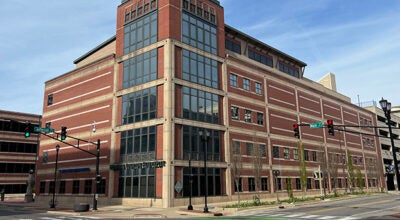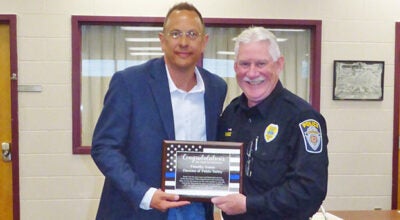DUHS freshman, 15, already disaster training veteran
Published 10:48 pm Thursday, October 7, 2010

Nick Bogen at Rotary Oct. 7 (The Daily News/John Eby)
By JOHN EBY
Dowagiac Daily News
Nick Bogen was accompanied to Dowagiac Rotary Club Thursday noon by CERT coordinator Patti Kolden of the Sheriff’s Office and Union High School life skills teacher Linda O’Keefe, but he did the talking.
His noon audience at Elks Lodge 889 included Cass County Sheriff Joe Underwood, Dowagiac Superintendent of Schools Dr. Mark Daniel and DUHS Principal Paul Hartsig.
CERT stands for Community Emergency Response Team.
The program educates citizens about what to do in the event of a disaster.
“We want people who can assist emergency responders,” said Nick, 15, a DUHS freshman who has been involved for more than a year since he tagged along to events with his grandparents.
Classwork can be crammed into a week or be conducted weekly “because not everybody has much time. I know I don’t,” Nick said. “I go to school, and that’s a lot of work.’
CERT originated in 1985 with the Los Angeles City Fire Department.
The 1987 earthquake only underscored the need.
“They had all this damage, and it was hard for police, fire and rescue people with roads blocked,” Nick said. “They started training people like me. More than 200 have been trained in Cass County. Just in case emergency rescuers cannot get to the location of survivors. That’s why we’re here. Our slogan is ‘the greatest good for the greatest number.’ We want to save as many people as possible.”
CERT members learn how to identify and anticipate hazards, reduce fire hazards in the home and workplace, extinguish small fires, assist emergency personnel and apply basic medical techniques.
“When you take the class,” Nick said, “the Fire Department comes out and you have a controlled burn that you help put out. Each participant goes out and helps. You extinguish the fire, then you back up. It’s really hands-on training. You have classroom, and you learn a lot of stuff, but then you have your hands-on training.”
Training sessions last up to two hours, he said.
“Session one is preparedness for families. CERT members are urged to get themselves organized in the event of a disaster. Say there’s an earthquake in Cass County — we’ve had one that woke me up and shook my medals on the wall — we’d try and get our house organized, then assist our community.”
Nick said fire suppression occupies the second training session, followed by two segments of disaster medical.
“You learn triage,” he said. “We use triage tape to wrap a victim if we find one.”
Triage tape is color-coded: red, injuries demanding urgent attention; yellow, delayed attention; green, “walking wounded”; and black, “the worst color you never want to see. That’s dead. We can’t help you.”
A fifth topic covered in CERT training is light search and rescue.
“We go in buildings if they’re structurally safe,” Nick explained. “If they aren’t, we cannot. We’re not professionals. We’re their assistants.
“If there’s a building that’s about to collapse, you’ll have to have your other resources, such as fire and EMS (emergency medical services) go in. We can’t if the building looks unsafe. In each room you announce, ‘My name’s Nick, I’m with CERT. Is anybody in here?’ You say that a couple of times. If there’s a response, you go in. If there’s not a response, there’s no reason to go in farther unless it’s a big house” with upstairs and downstairs levels.
Session six instructs about psychology and team organization.
“You learn about how your teams are going to be set up if you’re ever deployed by the sheriff’s department,” Nick said. “You gather with team members, five in a group. With something in Cass County, we’d be spread across the county. We wouldn’t all gather in one area and go all together.”
Seven, the “fun one,” combines a review of the previous material with putting it into action with a disaster simulation before graduation.
A drill Nick participated in at DUHS followed an explosion scenario.
“Mock disasters have ‘victims’ who are trained CERT members already and a scenario, whether it’s a tornado or an earthquake, you have to go around the building, if you can go in, and assess damage. If you find anybody, you have to set up triage (and assess) who’s in immediate need of care. Small teams help bring people out. “
When the drill ends, those same victims stage dramatic recoveries and evaluate the response by their rescuers.
Fun for Nick is the “special effects kit,” including disturbing injuries and lots of fake blood.
“In the tornado,” Nick related, “I was trapped under a piece of exercise equipment with a big gash on my leg. It was pretty neat.”
CERT mostly confines itself to traffic control, crowd control and first aid patrol at large events such as the fair, festivals and parades.
“I help at the fair every year,” Nick said.
“We all carry radios so we can talk about actions being taken and get support from paramedics. We get in free and walk around the fairgrounds patrolling. We can help. It doesn’t always have to be first-aid related. When we’re called out, we respond with whatever resources are available. I did storm spotting last year. You get trained by the National Weather Service. We gather information on which way it’s going before, during and after the storm.”
He also prevented a youngster from being run over while on traffic duty.
Charlie Gratz, who introduced Nick, said meeting him restored his faith and optimism in America’s future.






